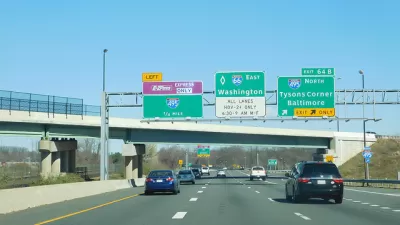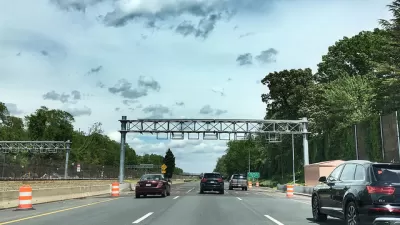An illustration of the intricate relationship between public transit and highways occurred on April 5 when two lines of the D.C. Metro broke down during the peak morning commute, sending many would-be riders to drive I-66 to D.C. instead.
"Metro had a nearly two-hour shutdown [from about 6:15 to 8 a.m.] on part of its Orange and Silver lines after smoke was reported at the Virginia Square station and in tunnels between Clarendon and Ballston" in Arlington, Va., reports Dana Hedgpeth for The Washington Post.
The influx of new drivers on Interstate 66 inside the Beltway who would otherwise have ridden the subway caused congestion, slowing speeds on the general purpose lanes. For solo drivers wanting a faster commute by opting to use the tolled 66 Express Lanes, which applies congestion pricing, i.e., the tolls increase with the level of congestion to keep minimum speeds above 45 mph, it wouldn't come cheap. Unlike many of the nation's other express lanes, the tolls have no upper limit, i.e., they are uncapped.
The $47 [eastbound morning] toll for the 10-mile stretch inside the Beltway was the third highest since the lanes made their debut in December. The high was $47.50 on Feb. 28 [see below], according to figures from the Virginia Department of Transportation.
The toll system is based on a “dynamic pricing” system that changes every six minutes, depending on demand, traffic and speed.
Not all vehicles using the express lanes pay tolls though. Drivers with at least one passenger traveled toll-free as the lanes are also high occupancy toll (HOT) lanes. Motorcyclists also travel toll-free. However, Teslas and other clean cars get no break without passengers.
Metro breakdowns not uncommon
Last Thursday's Metro breakdowns causing the 66 Express Lanes tolls to skyrocket was no anomaly.
On Feb. 28, there were lengthy delays for Metro riders on the Orange and Silver lines after a train had a brake problem at the Ballston station. Metro shut down rail service on part of the lines for about an hour. On that day, the eastbound I-66 toll peaked at $47.50, setting the record.
The subway-road toll relationship illustrates why it is good public policy to allow toll revenues to be used to improve transit service. Tolling need not be restricted to highways but also considered for urban cordons, as proposed in New York, Seattle, and potentially four California cities, to improve urban transit as well as other travel alternatives.
FULL STORY: ‘Took 3 hours to get to work’: Metro service suspension, $47 toll frustrate Virginia commuters

Study: Maui’s Plan to Convert Vacation Rentals to Long-Term Housing Could Cause Nearly $1 Billion Economic Loss
The plan would reduce visitor accommodation by 25,% resulting in 1,900 jobs lost.

North Texas Transit Leaders Tout Benefits of TOD for Growing Region
At a summit focused on transit-oriented development, policymakers discussed how North Texas’ expanded light rail system can serve as a tool for economic growth.

Why Should We Subsidize Public Transportation?
Many public transit agencies face financial stress due to rising costs, declining fare revenue, and declining subsidies. Transit advocates must provide a strong business case for increasing public transit funding.

How to Make US Trains Faster
Changes to boarding platforms and a switch to electric trains could improve U.S. passenger rail service without the added cost of high-speed rail.

Columbia’s Revitalized ‘Loop’ Is a Hub for Local Entrepreneurs
A focus on small businesses is helping a commercial corridor in Columbia, Missouri thrive.

Invasive Insect Threatens Minnesota’s Ash Forests
The Emerald Ash Borer is a rapidly spreading invasive pest threatening Minnesota’s ash trees, and homeowners are encouraged to plant diverse replacement species, avoid moving ash firewood, and monitor for signs of infestation.
Urban Design for Planners 1: Software Tools
This six-course series explores essential urban design concepts using open source software and equips planners with the tools they need to participate fully in the urban design process.
Planning for Universal Design
Learn the tools for implementing Universal Design in planning regulations.
City of Santa Clarita
Ascent Environmental
Institute for Housing and Urban Development Studies (IHS)
City of Grandview
Harvard GSD Executive Education
Toledo-Lucas County Plan Commissions
Salt Lake City
NYU Wagner Graduate School of Public Service




























